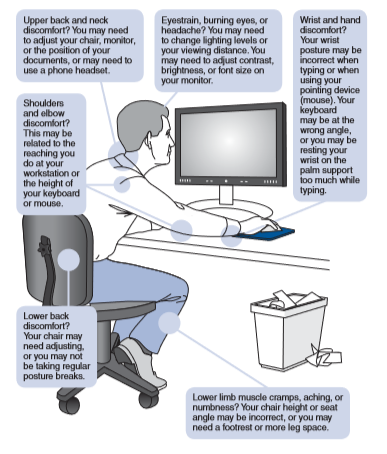Sports and Leisure for a Durable Return-To-Work
Practicing dance moves can be a step in the right direction when returning to work after an injury. Sports and leisure activities build skills and endurance that are often transferrable in the workplace. Our occupational therapists sometimes incorporate sports and leisure activities into treatment plans so workers return to their jobs in a timely and safe manner. This increases workplace productivity, decreases the number of absences and can reduce worksite accidents.
How OTs Use Sports and Leisure for Return to Work
When Melissa Ferguson, OT, first meets with a client, she wants to know, “What are some of the important activities for you in your life?” She asks her clients why they enjoy those activities. She chooses to focus on what lights her clients up and gets them excited, even when an injury feels like a barrier to participating. She uses task analysis to create a step by step breakdown on how to achieve a chosen final goal.
Through a gradual progression in frequency and intensity, Melissa helps her clients discover what they can do, rather than focusing on what they can’t.
The Benefits of Sports and Leisure
Melissa’s clients build up sports and leisure routines before returning to work. As a result, her clients arrive at their jobs better prepared with skills in stress and pain management as well as community activation and ergonomics.
Exercise and hobbies can improve both physical and psychological functioning when they become regular, personalized practices for a variety of reasons. They allow us to connect with members of our community. They foster a feeling of accomplishment and confidence. Sports and leisure also:
- develop habits to build structured routines
- hone motor skills
- prevent and improve back problems, especially through low-stress aerobics like walking and swimming
- reduce chronic pain through yoga, Pilates, and strength training
- support independent living for seniors and prevent falls
- release tension caused by repetitive tasks and desk set-ups
- foster mental wellbeing
Additional Resources
Educating yourself is a great first step to returning to recreational activities. Below are resources you can turn to for more information.
- “The Benefits of Recreation.” (City of Richmond)
- “Fearless Fitness: An Exercise Guide for People with Chronic Pain.” (CurableHealth.com)
- “Effects of Recreational Physical Activity and Back Exercises on Low Back Pain and Psychological Distress: Findings from the UCLA Low Back Pain Study.” (Authors: E. Hurwitz, H. Morgenstern, and C. Chiao)
Get Started with an OT
All of our therapists at OT Works! are certified with the College of Occupational Therapists of British Columbia (COTBC) and have additional training in areas such as mental health, brain injury rehabilitation, home safety and chronic pain.
If you or someone you know could benefit from occupational therapy after a motor vehicle accident or other injuries, contact us today! We are happy to answer any questions you may have.
E-mail: info@ot-works.com
Phone: 604.696.1066 ext 1000
Mental Health Week 2020: #GetReal
OT Works! is proud to acknowledge Mental Health Week. We would like to #GetReal and celebrate the efforts of all the healthcare professionals and people who are providing support during this COVID-19 period of occupational disruption.
Our occupational therapists provide clients with recommendations to manage their mental health and thrive. They can help you do what you need and want to do while working with current physical distancing measures in place in British Columbia.
Together, we can get through this period of occupational disruption, encourage healthy coping strategies, and end the stigma around mental health.
Learn More
Canadian Mental Health Association
A Quick Guide to Occupational Therapy Services: After A Motor Vehicle Accident
Occupational Therapy For Your ICBC Claim
After a motor vehicle accident, occupational therapy helps clients implement and maintain a sense of independence and balance in life. Occupational therapists focus on how clients participate in daily activities relative to their surroundings. They collaborate with their clients to help them function safely and effectively at home, work and in the community. Community OT is flexible and uses individualized, goal-oriented approaches in rehabilitation and health management.
When to Refer or Contact an OT
When an individual is injured in a motor vehicle accident in British Columbia, they are eligible to receive OT services under Part 7 Benefits. Usually ICBC requires a referral from a healthcare practictioner for occupational therapy in order to authorize funding. A doctor may recommend OT services if a client:
- Has not returned to work, school, volunteering or other pre-accident roles.
- Is struggling to care for themselves, their family or their home.
- Is still recovering slowly or not at all, despite other treatments.
Assessment
Once we receive a referral, we confirm with ICBC to ensure that funding is available. An OT Works! therapist can then reach out to the client to set up an initial assessment. During the first appointment, the OT will:
- Gain an understanding of the client’s pre-injury status.
- Observe the client doing functional tasks in their real environment(s), as well as standardized testing.
- Discuss a collaborative plan for treatment (if needed).
The therapist then provides a comprehensive report to ICBC and other healthcare providers involved in the client’s care. If necessary, further OT treatment may be recommended.
Throughout the process, OT Works! therapists help our clients be safe and comfortable. We encourage our clients to ask questions and take breaks when needed.
Hospital Discharge Program
When ICBC requests an OT assessment through the Hospital Discharge Program, occupational therapists help create a safe and timely transition to home for clients who have been hospitalized after their accident. Occupational therapists assess the need for adaptive equipment, home modifications or home support services such as cleaning services or a care aide’s support.
Longer-Term Care
OT Works! also helps ICBC clients who have not been hospitalized or who have been recovering for a longer period of time by the time of the referral. The therapist must determine if continuous OT treatment is necessary to enable a successful recovery. The assessment usually takes place at a client’s home or their workplace (e.g. job site visits, ergo assessments).
Treatment
If on-going occupational therapy is determined to be beneficial, then an OT will continue with the client and support their recovery with goal planning, regular appointments and support. Rehabilitation plans are customized for the client’s individual needs and goals. Here are some examples of the services our clients receive and the activities involved:
- Gradual Return-to-Work Planning and Monitoring helps people ease back into their work roles after time-off due to injuries. OTs can provide on- and off-site coaching through education, strategies and coping tools. They organize appropriate assistive and ergonomic equipment and advocate for return to work options with the client’s employer.
- Adaptive Equipment and Mobility Aids are put in place to ensure safety at home and in the community. Examples include adding a ramp or stair lift to navigate multilevel homes or assessing the safety and comfort of wheelchairs for those requiring assistance moving around.
- Exposure Therapy addresses a client’s anxiety, fear and discomfort so that they can actively engage in their community and life again. It is a gradual, step-by-step process that involves safe, accompanied exposure to locations or situations that trigger a client’s anxiety.
- Concussion Management helps people address the symptoms associated with impacts to the head. Occupational therapists provide education about what a typical recovery looks like. They help clients stay active after a concussion without overdoing it and determine strategies to work around the challenges they face.
- The Progressive Goal Attainment Program is an evidence-based program that reduces the barriers of disability by specifically targeting the psychological and social obstacles clients face. Goals are specific, measurable, achievable, realistic & relevant and time-based. We have several therapists that are certified to provide PGAP services.
Occupational therapists also provide a number of other services. Learn more here.
Case Studies: Successful Return to Work & Life
Theses three real-life case studies show the difference occupational therapy can make at various times in the recovery process after a motor-vehicle accident.
Get Started with an OT
All of our therapists at OT Works! are certified with the College of Occupational Therapists of British Columbia (COTBC) and have additional training in areas such as mental health, brain injury rehabilitation, home safety and chronic pain.
If you or someone you know could benefit from occupational therapy after a motor vehicle accident, contact us today! We can help you acquire funding from ICBC and answer any questions you may have.
Email: referrals@ot-works.com
Phone: 604.696.1066 ext. 1000.
ICBC Webpage: https://www.ot-works.com/services/ot-and-icbc-recovery/
Health & Safety in the Office: Ergonomics
An effective workspace is essential to feeling well at work and wherever else. Ergonomic changes to your workspace promote good posture and contribute to physical wellbeing. They also allow better efficiency with tasks. Consider the ergonomic recommendations below and seek professional help from a registered occupational therapist if you need more help.
Ergonomic Recommendations
Consider the following:
- Posture.
- Are you sitting up straight?
- Are your shoulders relaxed?
- Are you leaning forward, creating tension in your back?
- The height of your chair.
- Are your forearms horizontal, your wrists straight, and your thighs at a 90 – 110 degree angle at the hips?
- Does the lower part of your backrest support the curve of your back?
- Do you have armrests, to decrease the strain on your back and neck?
- Your computer monitor.
- Is the top line of text on the screen at eye level?
- Is the screen an arm’s length away from your eyes?
- Do you need to adjust the contrast, brightness, or font size on the screen?
- Your visual needs.
- WorkSafe BC has a list of information to share with your ophthalmologist or optometrist regarding your desk and computer work.
- Do you need to lower the overhead light levels to prevent glare?
- Do you need to move your desk lamp (to the opposing side to your dominant hand)?
- Your work area organization.
- Are frequently used items close to you (within a 30 cm reach)?
- Are occasionally used items within an arm’s reach to you (within a within a 50 cm reach)?
- Are any rarely used items put away or set further aside?
- Your phone set up.
- Do you use a headset or speakerphone to avoid awkward neck positions?

Take short breaks (20 sec. to 2 min.) to allow your muscles to rest between repetitive activities. On longer breaks, stand up and walk around so that you use different muscles than while sitting. Try basic exercises like these here or here to help you prevent strains at work.
You may find an ergonomic assessment by an OT to help address any issues you have. Contact us and we will be happy to have an occupational therapist come to you.
E-mail: info@ot-works.com
Phone: 604.696.1066 ext 1000
Resources
- “Ergonomics & Computer Use.” University Health Services at Princeton University. https://uhs.princeton.edu/health-resources/ergonomics-computer-use
- “Office Ergonomics.” HealthLink BC. https://www.healthlinkbc.ca/health-topics/tr5915
- “How to Make Your Computer Workstation Fit You.” WorkSafeBC. https://www.worksafebc.com/en/resources/health-safety/books-guides/how-to-make-your-computer-workstation-fit-you
SMART Resolutions
OT Works! takes the SMART approach to goal setting. We help our clients clearly define their goals and put steps in place so that they can achieve them. Using approaches similar to ours, you can successfully maintain your New Years’ resolution.
Occupational therapy is goal-oriented. Our clients may want to bear a certain weight with their arms. They may work towards returning to work full-time. Perhaps, they want to be able to go about their daily routines as independently as possible. We use SMART goal-planning to make that happen. It is a popular technique that works for many.
If your goal is unrelated to the examples above, that is okay. Try this method out and maybe you will achieve your goal too.
Setting Up Your Goal
Specific
- Your goal should be well defined and clear.
- Ask yourself:
- What am I trying to accomplish?
- Why am I pursuing this goal?
- Who is involved?
- Where is my goal, or where will I work towards obtaining it?
- Which resources do I need and which barriers do I face?
- When will I start? When will I meet my goal?
Measurable
- Know how far you are from completing your goal.
- Ask yourself:
- How much or how many do I need?
- How will you know once you have achieved your goal?
Achievable
- Your support network can help motivate you so that you aren’t overwhelmed.
- Ask yourself:
- Are those people who can help me (such as friends, family, health professionals, and/or employers) aware of my goal?
- What resources or support can they provide?
Realistic and Relevant
- Be honest with yourself.
- Ask yourself:
- Do I have the resources, knowledge and support to achieve my goal?
- Does my goal support my current or future needs?
Time-Based
- Check that you have the right amount of time
(not too much, not too little) to achieve your goal. - Ask yourself:
- When will I aim to accomplish my goal?
- What steps will I take along the way?
- What can I do today?
PGAP
Besides SMART goals, some therapists at OT Works! are trained in the Progressive Goal Attainment Program. To deliver PGAP services, occupational therapists require additional training and a certificate. PGAP is an evidence-based program that reduces the barriers of disability by specifically targeting the psychological and social obstacles clients face. PGAP aims to increase a client’s quality of life and to assist them with their return to work. If you would like to inquire further about PGAP, please contact referrals@ot-works.com.
Learn More
- SMART Goals – https://www.projectsmart.co.uk/smart-goals.php
- SMART Goals – https://www.drjulieconnor.com/smart-personal-goals/
- PGAP – https://www.pgapworks.com/en/index.php
- For more information about our OT Works! therapists can help you achieve your health-related goals, visit https://www.ot-works.com





